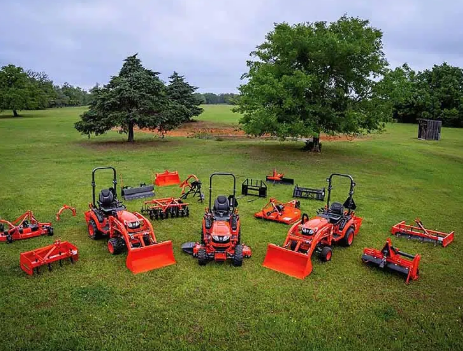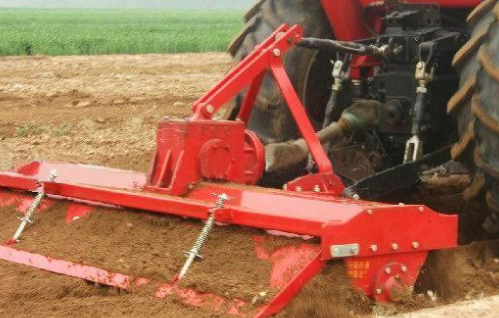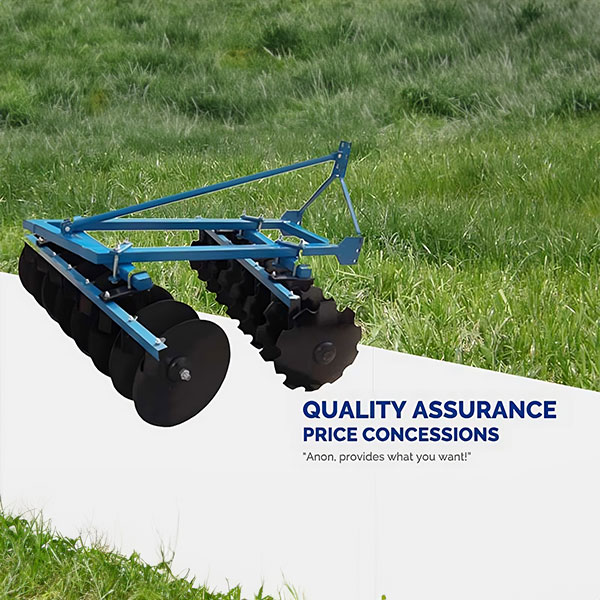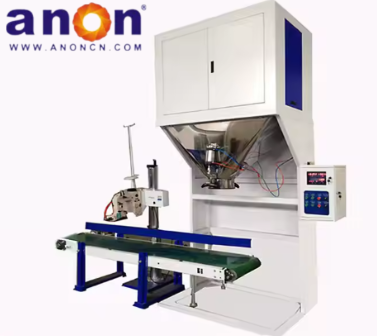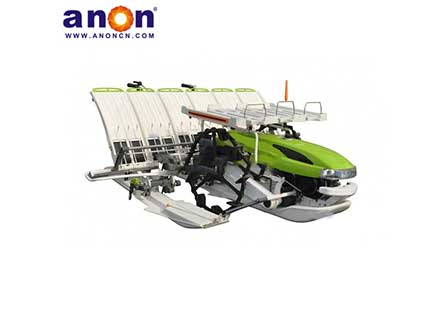Introduction
Disc ploughs and disc harrows are great helpers in farming. The disc blade is the most important working part of both tools. Its quality directly affects their efficiency and service life. But do you know how these disc blades are made? Today, I’ll show you the manufacturing process behind them. If you’re interested, keep reading!
What Are Plow and Harrow Blades?
Plow and harrow blades are circular metal discs mounted on disc plows or disc harrows, widely used in agricultural soil tillage and land preparation. During operation, these blades rotate and cut into the soil, helping to break up clods, turn the soil, and bury crop residues and weeds. They are essential components for achieving efficient mechanized farming.
Disc plows, with their sharp edges, quickly slice through surface vegetation and turn it into the soil, preparing an ideal seedbed for the next planting season. Disc harrows are typically used after plowing to further break up soil clumps, level the surface, and improve seeding quality.
Processing process
| STEP 1 | STEP 2 | STEP 3 | STEP 4 | |
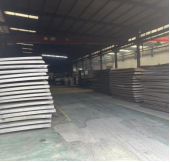 |
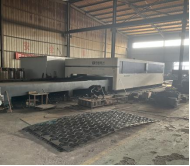 |
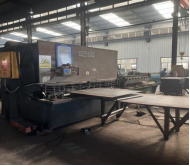 |
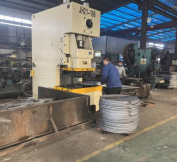 |
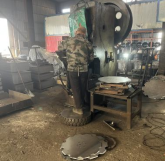 |
| Raw Material | Machine cutting plate cutting | Laser Cutting | Cut to roundness | Cutting notch |
| STEP 5 | STEP 6 | STEP 7 | STEP 8 | STEP 9 |
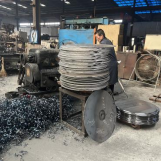 |
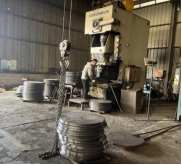 |
 |
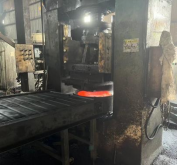 |
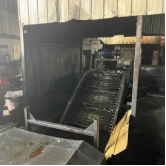 |
| Milling edge | Press Logo | Heat treatment | Hot-press mould | Boron molten steel quenching |
| STEP 10 | STEP 11 | STEP 12 | STEP 13 | STEP 14 |
 |
 |
 |
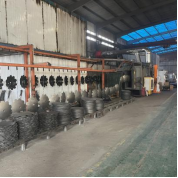 |
 |
| Water temperature control in the cooling tower | Tempering insulation | Steel sand shot blasting | Electrostatic Powder painting | Packaging |
Raw Material Preparation
The first step is preparing the steel. Common materials include 65Mn spring steel, 50Mn steel, manganese steel, and boron steel. These materials are widely used for disc blades because they offer good toughness, excellent wear resistance, and strong heat treatment performance. Before production begins, it’s important to choose the right type of steel and ensure that enough raw material is available for processing.
Cutting and Shaping
Steel is usually supplied in full sheets. If the material is punched into circles without optimized cutting, a large amount of scrap will be wasted. To avoid this, manufacturers typically use laser cutting or plasma cutting with nesting software to lay out the discs directly on the steel sheet. This maximizes material usage and reduces cost. After cutting, the edges are trimmed using an angle grinder or a deburring machine to ensure smooth, burr-free edges.
Openings and cutouts
The third step is to make holes and openings. Because the plow blade and the harrow blade need the middle hole to connect with the transmission shaft for ploughing, and the holes are more convenient for subsequent processing. If you are making a disc harrow, you need to make notches on the edge of the disc.
Sharpening the edge
Next is sharpening the edge. The disc is fixed on a grinding machine, ensuring it can rotate freely. Then, based on the design specifications, the angle between the edge and the grinding wheel is adjusted. The sharpening machine is started, and pressure is applied evenly along the edge, maintaining a stable angle. Each side of the edge is ground for 3-5 minutes until the edge has a uniform, shiny finish.
Press Logo
This step refers to a process in disc blade manufacturing where a mold is used to stamp information such as the brand name, specifications, and batch number onto the surface of the steel plate. It can also include material codes or process identifiers. This makes it easier to identify the manufacturer and model, and in case of quality issues, it helps trace responsibility and improve the production process.
Heat treatment
Next is the heat treatment stage. During heating, the disc is brought to the austenitizing temperature, which improves the material’s plasticity and ductility, making it easier for subsequent shaping processes like pressing and forging. At the same time, during heating, the carbides inside the material dissolve, and the structure becomes more uniform, helping to reduce segregation and defects.
Profiling
The discs for both the plough and harrow are concave-shaped, and this shape is formed during the pressing stage. After the heating process, the red-hot discs are quickly fed into the pressing mold, where they are shaped into the required form.
Quenching
Quenching is a key heat treatment process that improves the wear resistance, strength, and toughness of the disc blades. The principle involves heating the steel above its critical temperature, holding it for a period, and then cooling it at a rate faster than the critical cooling speed. This process results in a high-hardness structure, mainly martensite. Proper control of quenching parameters is essential to avoid excessive brittleness and ensure the plough and harrow discs can withstand impact during cultivation.
There are two main types of quenching: oil quenching and water-based quenching. Typically, manganese steel is oil quenched, while boron steel uses water-based quenching solutions. Quenching increases the hardness of the disc blades to 50-60 HRC. However, at this stage, the disc blades cannot be used yet because they are too hard and may easily fracture.
Tempering
Annealing and tempering are processes used to reduce hardness, eliminate internal stresses and brittleness, and improve the metal’s toughness and ductility. For 65Mn steel, a hardness of 40-44 HRC is considered the optimal condition after tempering, while for boron steel, a hardness of 44-48 HRC is ideal. Before heat treatment, the hardness is only around 7-9 HRC.
During tempering, the discs are stacked and sent into the tempering furnace in layers. To ensure uniform heating for each disc, a small ring is placed beneath each one. This helps guarantee consistent heating during tempering, ensuring high-quality results.
Water explosion
After tempering, the disc blades are placed in water for rapid cooling, a process known as water quenching. The discs are stacked and immersed in a water tank, where the water quickly absorbs a large amount of heat, allowing the discs to cool down and solidify into their final shape.
Check leveling
After the water quenching, the discs need to go through a leveling check. Each disc is placed upside down on a leveling platform to inspect the evenness of its edges. Every single disc must be checked to ensure consistent quality.
Shot Blasting
Shot blasting involves using a high-speed rotating wheel to throw small steel shots or grit onto the surface of the workpiece. This process cleans, strengthens, or roughens the surface. After water and heat treatment, the surface of the disc blades often has oxide scale or rust. Shot blasting effectively removes these impurities and prepares the discs for the next steps.
The process also creates a certain level of surface roughness, which greatly improves the adhesion of paint or powder coating. This makes the coating more durable, less likely to peel off, and enhances the disc’s corrosion resistance.
Additionally, shot blasting introduces compressive stress on the disc surface, which increases resistance to cracking and fatigue. This helps the discs withstand the demands of high-intensity agricultural work, making them more durable and less prone to breaking.
Finally, shot blasting gives the disc blades a more uniform and consistent surface, free of major scratches or defects—an important factor for passing final appearance inspections.
Plastic spraying
In the manufacturing process of plough and harrow discs, powder coating (also known as electrostatic powder spraying) is the final and very important surface treatment step. It not only improves the appearance of the discs but also significantly enhances their performance and durability.
In agricultural environments, mud, water, and fertilizers are all highly corrosive. The powder coating forms a dense protective layer that effectively prevents rust and corrosion, greatly extending the lifespan of the discs. The coating itself also has a certain level of hardness and toughness, allowing it to withstand friction, impact, and flying debris during field work. This helps reduce wear and tear on the disc blades and keeps them performing longer under harsh conditions.
Packaging
After the disc harrow blades go through powder coating and curing, the protective layer becomes fixed and durable.
At this stage, the blades are ready for packing and boxing, making them convenient for further assembly into complete plows or harrows or for direct sale.
The influence of processing technology on the performance of disc blades
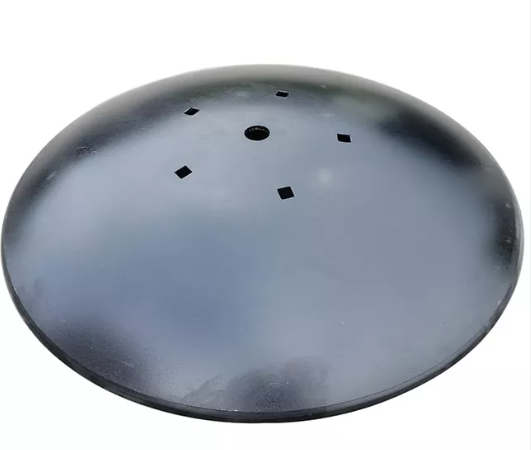
Balance between strength and toughness
The strength of the disc mainly depends on the hardness of the material and the depth of heat treatment, which can effectively resist wear and improve cutting ability.
Resilience refers to ensuring that the disc is not easily cracked or shattered under high-intensity operation, especially suitable for complex soil or rocky areas.
In order to achieve the optimal balance between the two, a heat treatment strategy of surface hardening and core toughness preservation is usually adopted in production. For example:
Surface hardness is controlled at HRC 38-48 to enhance wear resistance; The core retains a certain degree of plasticity, enhances impact resistance, and avoids brittle cracking. This heat treatment process has extremely high requirements for heating temperature, quenching medium, tempering time, etc., and is the core technical link to ensure stable performance.
Key technical points for improving lifespan
The service life of plow blades depends not only on the material itself, but also on the following key technical control points:
Firstly, the selection of materials should be high-carbon alloy materials such as high-manganese steel and 65Mn spring steel, which have good hardenability and wear resistance. Then, the molding accuracy of the mold should be high, ensuring consistent shape and uniform thickness through mold pressing, and reducing early damage caused by stress concentration. Finally, it is important to ensure uniform and consistent heat treatment. Intermediate frequency induction quenching or box furnace quenching can be used to achieve uniform heat treatment of the entire cutting surface and reduce local hardness and brittleness.
How to reduce the cracking rate and wear rate
In actual farmland operations, the most common damage problems of plow blades are cracking and excessive wear. To address these two types of issues,
The first heat treatment process needs to be precisely controlled. Adopting constant temperature tempering technology to eliminate residual stresses from quenching and reduce the risk of cracking caused by internal stress accumulation.
The second method is to use automated quenching and tempering equipment to ensure stable hardness in each batch and reduce local rapid wear caused by uneven hardness.
Optimize the structure of the molding mold: make the one-sided force more uniform and reduce the possibility of edge stress concentration.
Thirdly, local thickening design. Strengthen the structure of severely worn areas (such as cutting edges) to increase their service life.
Conclusion
We hope that after reading this article, you now have a deeper understanding of how plough and harrow disc blades are made. At ANON Agricultural Machinery, we always put quality first and strive for customer satisfaction. We are committed to providing professional, reliable agricultural equipment to meet your needs.
If you’re looking for high-quality farming machinery, feel free to reach out to us—we’re here to help!
FAQ
1. What is the thickness of the disc harrow blades?
Disc harrow blades range in thickness from 2mm (14 gauge) to 10mm (3 gauge) to suit your soil conditions. We also offer disc harrow blades in standard and deep concave. Center hole punches include round, square, square-round staggered, and square-staggered center holes.
2. What are harrows made of?
Harrows come in a variety of types and weights, depending on their intended use. They almost always consist of a rigid frame that supports discs, teeth, chains, or other devices that move the soil, but tooth and chain rakes are usually supported only by a rigid drawbar at the front of the rake group.
3. What is a Blade harrow used for?
Blade harrows are used for different purposes like the removal of weeds and stubble, crushing of clods, working of soil to a shallow depth, covering the seeds, intercultivation, and harvesting of groundnut, etc.
4. What is the difference between plowing and harrowing?
Plowing helps break up clods and hard, compacted soil into pieces for good root development of crops. Harrowing is a land preparation operation that helps break up clods further into smaller pieces, thus forming well-aerated and flat cultivated soil.



